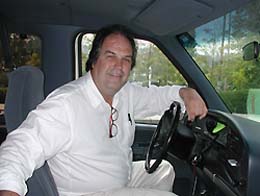On February 17, 1998, State and Seattle City Government officials create a 12-member citizens board for the Elevated Transportation Company (ETC), a public development authority company created by Initiative 41. Governor Gary Locke, Mayor Paul Schell, and Seattle City Council President Sue Donaldson each appoint four members to the board, in accordance with the monorail plan approved by Seattle voters (Initiative 41) by a 53 percent majority on November 4, 1997. On November 5, 2002, Seattle voters will approve Proposition 1 to create the Seattle Popular Monorail Authority (SPMA) to replace the ETC, and give it the authority to design, build, and operate the 14-mile Green Line monorail as the first line in a city-wide monorail system. In 2005, following cost overruns and revenue shortfalls, Seattle voters will kill the Seattle monorail project they had supported in four earlier votes.
How It All Began
Dick Falkenbury, a Seattle cab driver and community activist who led the movement for an extended monorail in Seattle beginning in 1992, and Grant Cogswell, a Seattle poet-activist, wrote initiative 41. The Initiative called for a 40-mile, X-shaped elevated transportation system to link the city’s four corners with downtown. Initiative 41 attached no levies to pay for its immediate funding, but called for the creation of a company to seek private capital for the elevated system’s design and construction -- with the City backing up the company if it could not obtain private capital.
The newly created Elevated Transportation Company received its first year’s operating expenses ($200,000) out of City emergency funds in early February, and on February 17th -- the last day by which the City had to create the public development authority in accordance with the initiative -- officials chose the 12-member board.
Eighty-nine candidates -- people with backgrounds in engineering, finance, and other related skills -- sought appointment to the board, and officials also considered some people who did not apply for the position. On January 28, at a Friends of the Monorail dinner meeting, 31 of the 89 candidates each gave a one-minute speech about his or her ideas and qualifications for appointment. The Civic Foundation, a civic watchdog group, sponsored the meeting to discuss how the expanded monorail could work together with the Regional Transit Authority’s (RTA) Light Rail line plan. More than 200 people attended.
The Appointments
Governor Gary Locke appointed: Lois North, the former chairwoman of the King County Council; Gwendolyn Lee, the business manager for the International Brotherhood of Electrical Workers Local 46; Yvonne Sanchez, a community resource manager for the State Department of Social and Health Services (now director of the City of Seattle Department of Neighborhoods); and Claude Forward, a retired Boeing employee and neighborhood activist.
Mayor Paul Schell named: Dick Falkenbury, leader of the Monorail Initiative; Marie Groark, a public sector management consultant with Price Waterhouse; Walt Crowley, a writer and local historian; and Charles Hamilton, a Capitol Hill community activist and small-business owner.
Seattle City Council President Sue Donaldson named: Tom Carr, a member of two Metro transit advisory groups (now a Seattle City Attorney); Neil Heiman, executive director of the University District Chamber of Commerce; Richard Collins, a Boeing project manager; and Kristina Hill, Assistant Professor of landscape architecture at the University of Washington.
The $200,000 the Mayor and the City Council had approved shortly before appointing the board was to fund ETC’s operating expenses and the hiring of a single staff member only (Paul Elliott). The board positions were voluntary. Seattle City Council approved the 12 nominated candidates by a full Council vote soon after their nominations.
On November 5, 2002, Seattle voters approved Proposition 1 to create the Seattle Popular Monorail Authority (SPMA) to replace the ETC, and gave it the authority to design, build, and operate the 14-mile Green Line monorail as the first line in a city-wide monorail system. However, in 2005, following cost overruns and revenue shortfalls, Seattle voters killed the Seattle monorail project they had supported in four earlier votes.

